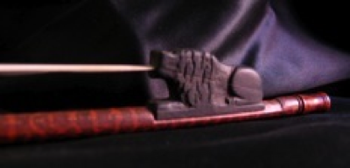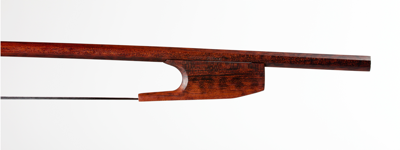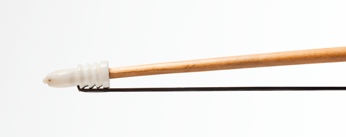
About period bows

Being a professional musician and playing alongside other players enables me to play my bows myself to feel and hear how they work, but also to see them under other fingers, and receive feedback from some of the finest period musicians in the U.K. This is especially important for the cello and double bass as they are instruments I don't play myself.
The bows I make are mainly copies of extant originals, ones I have seen, played and measured myself; either from other players, or museum collections. There are very few extant bows from before the 1700s, but fortunately many of the painters from this period have very exact details: one can measure the strings, see length, wood species, colour of hair from the paintings, and I am very happy to reconstruct bows from iconography.
Some of the main differences between modern and period bows:
The length: bows increase in length throughout the ages, in the renaissance and early baroque many extant bows are only as long as the violin itself.
 Clip-in bows: The screw mechanism was not in common usage until the mid 18th century (whilst invented earlier). Screws and eyes were handmade, the invention of a lathe to make taps and dies comes in mid-century which would have required new tools, and different skills; and the metal amalgams were not considered particularly reliable. The acoustic qualities of the bow change with screw as opposed to clip-in, and as most new-fangled ideas take some time to become the norm, I doubt it was different amongst bow makers in the 1700s.
Clip-in bows: The screw mechanism was not in common usage until the mid 18th century (whilst invented earlier). Screws and eyes were handmade, the invention of a lathe to make taps and dies comes in mid-century which would have required new tools, and different skills; and the metal amalgams were not considered particularly reliable. The acoustic qualities of the bow change with screw as opposed to clip-in, and as most new-fangled ideas take some time to become the norm, I doubt it was different amongst bow makers in the 1700s.
Black hair: The clip-in bow was mostly haired with dark hair, which is more stable, and less susceptible to climatic change than its white counterpart. It also has a more speaking 'bite' on the string than white hair, therefore more carrying power; and for those players using equal tension all gut strings it makes playing the lower strings far easier. I would advise players wanting a clip-in to have black or brown hair.
Less hair: baroque music has more emphasis on the speaking nature of music, rather than the long, smooth bel canto lines needed from a later, or modern bow. Less hair gives a clearer sound, and also helps with more articulation. Modern violin bows average around 150 hairs, whereas a baroque bow likely to have closer to 90. Baroque bows have smaller heads than their modern counterparts, and therefore also less room for so much hair!
 Different woods: Whilst modern bows are made usually from pernambuco, early bows are made from a variety of woods including tropical hardwoods such as snakewood, ironwood, ebony and softer fruit woods. Fruit woods are native to Europe, and the other woods came over in the first days of the many European empires. See the woods page for more details on the different woods.
Different woods: Whilst modern bows are made usually from pernambuco, early bows are made from a variety of woods including tropical hardwoods such as snakewood, ironwood, ebony and softer fruit woods. Fruit woods are native to Europe, and the other woods came over in the first days of the many European empires. See the woods page for more details on the different woods.